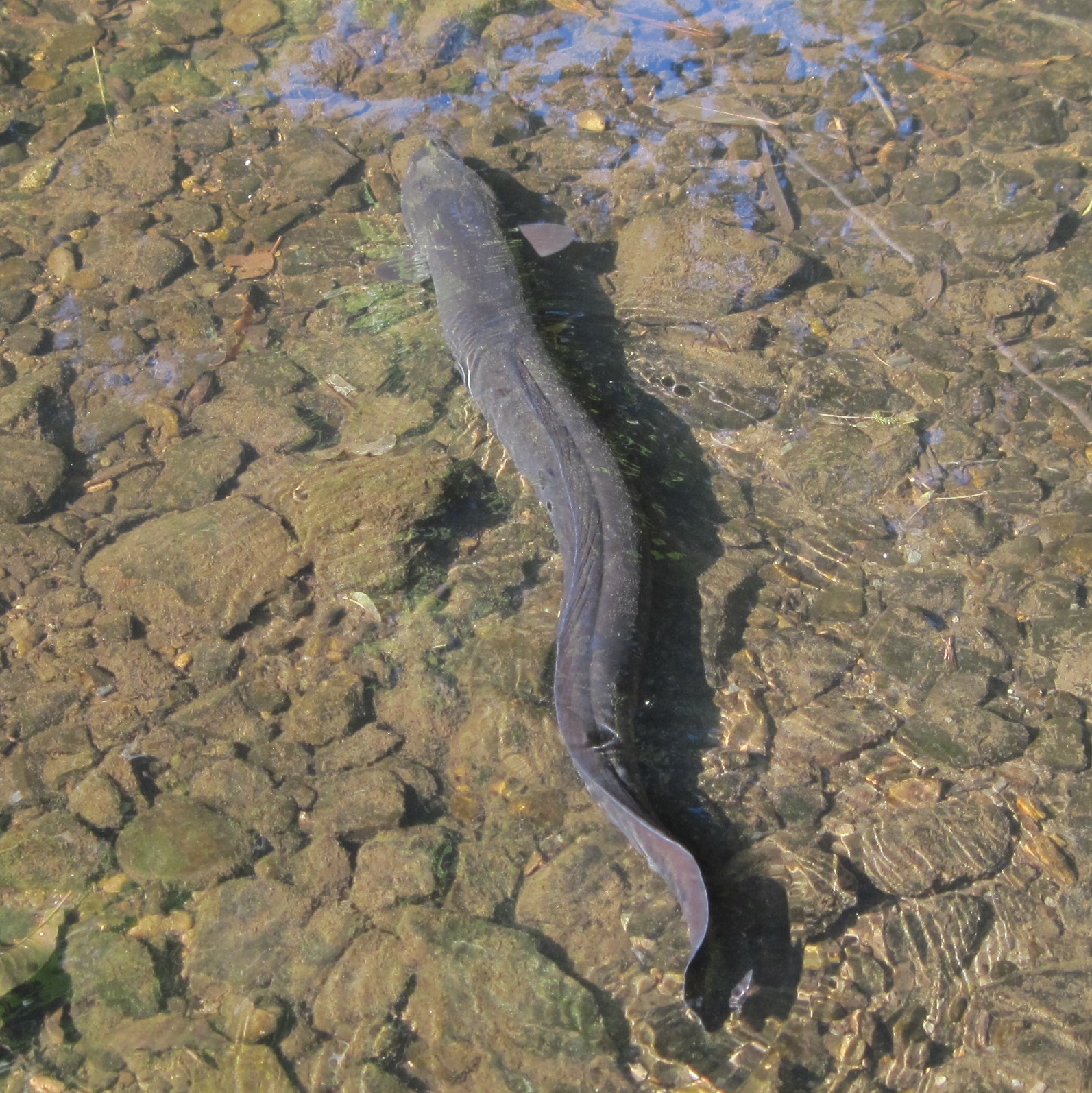|
Eel
Eels are ray-finned fish belonging to the order Anguilliformes (), which consists of eight suborders, 19 families, 111 genera, and about 800 species. Eels undergo considerable development from the early larval stage to the eventual adult stage and are usually predators. The term "eel" is also used for some other eel-shaped fish, such as electric eels (genus ''Electrophorus''), spiny eels (family Mastacembelidae), swamp eels (family Synbranchidae), and deep-sea spiny eels (family Notacanthidae). However, these other clades evolved their eel-like shapes independently from the true eels. Eels live both in salt and fresh water, and some species are catadromous. Description Eels are elongated fish, ranging in length from in the one-jawed eel ('' Monognathus ahlstromi'') to in the slender giant moray. Adults range in weight from to well over . They possess no pelvic fins, and many species also lack pectoral fins. The dorsal and anal fins are fused with the caudal fin, f ... [...More Info...] [...Related Items...] OR: [Wikipedia] [Google] [Baidu] |
Anguilla (genus)
The Anguillidae are a family (biology), family of Actinopterygii, ray-finned fish that contains the freshwater eels. Eighteen of the 19 extant taxon, extant species and six subspecies in this family are in the genus ''Anguilla''. They are elongated fish with snake-like bodies, their long dorsal, caudal and anal fins forming a continuous fringe. They are catadromous fish, spending their adult lives in freshwater, but migrating to the ocean to Spawn (biology), spawn. Eels are an important food fish and some species are now aquaculture, farm-raised, but not bred in captivity. Many populations in the wild are now threatened, and Seafood Watch recommend consumers avoid eating anguillid eels. Physical description Adult freshwater eels are elongated with tubelike, snake-shaped bodies. They have large, pointed heads and their dorsal fins are usually continuous with their caudal and anal fins, to form a fringe lining the posterior end of their bodies. They have relatively well develope ... [...More Info...] [...Related Items...] OR: [Wikipedia] [Google] [Baidu] |
Anguilla Japonica
The Japanese eel (''Anguilla japonica''; Japanese: 日本鰻 ''nihon'unagi'') is a species of anguillid eel found in Japan, Korea, China, and Vietnam, as well as the northern Philippines. There are three main species under the Anguilla genus, and all three share very similar characteristics. These species are so similar that it is believed that they spawned from the same species and then experienced a separation due to different environments in the ocean. Like all the eels of the genus ''Anguilla'' and the family Anguillidae, it is catadromous, meaning it spawns in the sea but lives parts of its life in freshwater. Raised in aquaculture ponds in most countries, the Japanese eel makes up 95% of the commercially sold eel in Japan, the other 5% is shipped over by air to the country from Europe. This food in Japan is called ''unagi''; they are an essential part of the food culture, with many restaurants serving grilled eel called '' kabayaki''. However, presumably due to a combination ... [...More Info...] [...Related Items...] OR: [Wikipedia] [Google] [Baidu] |
Electric Eel
The electric eels are a genus, ''Electrophorus'', of neotropical freshwater fish from South America in the family Gymnotidae. They are known for their ability to stun their prey by generating electricity, delivering shocks at up to 860 volts. Their electrical capabilities were first studied in 1775, contributing to the invention in 1800 of the electric battery. Despite their name, electric eels are not closely related to the true eels (Anguilliformes) but are members of the electroreceptive knifefish order, Gymnotiformes. This order is more closely related to catfish. In 2019, electric eels were split into three species: for more than two centuries before that, the genus was believed to be monotypic, containing only '' Electrophorus electricus.'' They are nocturnal, air-breathing animals, with poor vision complemented by electrolocation; they mainly eat fish. Electric eels grow for as long as they live, adding more vertebrae to their spinal column. Males are larger than fe ... [...More Info...] [...Related Items...] OR: [Wikipedia] [Google] [Baidu] |
Protanguilloidei
''Protanguilla palau'' is a species of eel, the only species in the genus ''Protanguilla'' (first eel), which is in turn the only genus in its family, Protanguillidae. Individuals were found swimming in March 2010 in a deep underwater cave in a fringing reef off the coast of Palau. Protanguillidae is a sister group to all other eels.Springer, V. G. (2015). The Gill-Arch Musculature of Protanguilla, the Morphologically Most Primitive Eel (Teleostei: Anguilliformes), Compared with That of Other Putatively Primitive Extant Eels and Other Elopomorphs, 103(2), 595–620. doi: 10.1643/CI-14-152 They are monophyletic, yet also strongly synapomorphic with all other eel species. Molecular analysis shows that all other eels are also monophyletic, showing that they may have broken off directly from the Protanguillidae. for this reason it's known as a "Living Fossil." Characteristics The body is very small and slender, about 18 cm long. [...More Info...] [...Related Items...] OR: [Wikipedia] [Google] [Baidu] |
Muraenoidei
Muraenoidei is a suborder of eels in the order Anguilliformes which contains the following three families: * Heterenchelyidae (Mud eels) * Myrocongridae (Thin eels) * Muraenidae Moray eels, or Muraenidae (), are a family of eels whose members are found worldwide. There are approximately 200 species in 15 genera which are almost exclusively marine, but several species are regularly seen in brackish water, and a few are f ... (Moray eels) References Eels Ray-finned fish suborders {{Anguilliformes-stub ... [...More Info...] [...Related Items...] OR: [Wikipedia] [Google] [Baidu] |
Chlopsoidei
The Chlopsidae, or false morays, are a family of eels found in coral reefs worldwide. As their name suggests, they somewhat resemble moray eels in appearance. However, they are smaller than true morays, ranging from in length. Genera The family contains these genera: Family Chlopsidae * Genus '' Boehlkenchelys'' * Genus ''Catesbya'' * Genus ''Chilorhinus'' * Genus ''Chlopsis'' * Genus ''Kaupichthys'' * Genus ''Powellichthys'' * Genus ''Robinsia'' * Genus ''Xenoconger ''Xenoconger'' is a genus of eels in the family Chlopsidae (false morays). It contains the single species ''Xenoconger fryeri'', or Fryer's false moray. [...More Info...] [...Related Items...] OR: [Wikipedia] [Google] [Baidu] |
Congroidei
Congroidei is a suborder of eels in the order Anguilliformes. It contains five families: * Derichthyidae (Longneck eels) * Ophichthidae (Snake eels and worm eels) * Muraenesocidae (Pike congers) * Nettastomatidae (Duckbill eels) * Congridae The Congridae are the family of conger and garden eels. Congers are valuable and often large food fishes, while garden eels live in colonies, all protruding from the sea floor after the manner of plants in a garden (thus the name). The family i ... (Congers and garden eels) References Eels Ray-finned fish suborders {{Anguilliformes-stub ... [...More Info...] [...Related Items...] OR: [Wikipedia] [Google] [Baidu] |
Moringuoidei
The Moringuidae are a small family of eel Eels are ray-finned fish belonging to the order Anguilliformes (), which consists of eight suborders, 19 families, 111 genera, and about 800 species. Eels undergo considerable development from the early larval stage to the eventual adult stage ...s commonly known as spaghetti eels or worm eels, although the latter name is also shared with other families of eels. Moringuid eels are found in shallow tropical waters worldwide. They range from about to in length, and have very narrow, cylindrical bodies, giving rise to their common name. The family contains 14 species in its two genera. References Marine fish families Eels Ray-finned fish families {{anguilliformes-stub ... [...More Info...] [...Related Items...] OR: [Wikipedia] [Google] [Baidu] |
Conger Conger Gervais
''Conger'' ( ) is a genus of marine congrid eels. It includes some of the largest types of eels, ranging up to 2 m (6 ft) or more in length, in the case of the European conger. Large congers have often been observed by divers during the day in parts of the Mediterranean Sea, and both European and American congers are sometimes caught by fishermen along the European and North American Atlantic coasts. The life histories of most conger eels are poorly known. Based on collections of their small leptocephalus larvae, the American conger eel has been found to spawn in the southwestern Sargasso Sea, close to the spawning areas of the Atlantic freshwater eels. "Conger" or "conger eel" is sometimes included in the common names of species of the family Congridae, including members of this genus. Description Congers have wide mouths with sturdy teeth, usually a variant of gray or black in coloration. They have no scales. Their body weight can reach over 57 kilograms (125 l ... [...More Info...] [...Related Items...] OR: [Wikipedia] [Google] [Baidu] |
Anguilloidei
The Anguilloidei are a suborder of the order Anguilliformes (the eels) containing three families: *Anguillidae (freshwater eels) *Serrivomeridae (sawtooth eels) *Nemichthyidae (snipe eels) This suborder traditionally included several other families that have recently been moved to new suborders: Chlopsidae (false morays), Heterenchelyidae (mud eels), Moringuidae (worm eels), Muraenidae (moray eels), and Myrocongridae ''Myroconger'' is the only genus of eels, the thin eels, in the family Myrocongridae. Very little is known about the group. Until recently, only a single specimen from this family was known. This individual had been caught off Saint Helena in 18 ... (thin eels). References * Eels Ray-finned fish suborders {{Anguilliformes-stub ... [...More Info...] [...Related Items...] OR: [Wikipedia] [Google] [Baidu] |
Swamp Eel
The swamp eels (also written "swamp-eels") are a family (Synbranchidae) of freshwater eel-like fishes of the tropics and subtropics. Most species are able to breathe air and typically live in marshes, ponds and damp places, sometimes burying themselves in the mud if the water source dries up. They have various adaptations to suit this lifestyle; they are long and slender, they lack pectoral and pelvic fins, and their dorsal and anal fins are vestigial, making them limbless vertebrates. They lack scales and a swimbladder, and their gills open on the throat in a slit or pore. Oxygen can be absorbed through the lining of the mouth and pharynx, which is rich in blood vessels and acts as a "lung". Although adult swamp eels have virtually no fins, the larvae have large pectoral fins which they use to fan water over their bodies, thus ensuring gas exchange before their adult breathing apparatus develops. When about a fortnight old they shed these fins and assume the adult form. Most spe ... [...More Info...] [...Related Items...] OR: [Wikipedia] [Google] [Baidu] |
Synaphobranchoidei
Cutthroat eels are a family, Synaphobranchidae, of eels, the only members of the suborder Synaphobranchoidei. They are found worldwide in temperate and tropical seas. Cutthroat eels range from in length. They are bottom-dwelling fish, found in deep waters down to about . They are distinguished by the presence of telescopic eyes in the larvae. In some classifications (for example, ITIS), this family is split, with ''Simenchelys The snubnosed eel, ''Simenchelys parasitica'', also known as the pug-nosed eel, slime eel, or snub-nose parasitic eel, is a species of deep-sea eel and the only member of its genus. Some authors classify it as the sole member of the subfamily Sim ...'' in its own family, the Simenchelyidae. References * {{anguilliformes-stub ... [...More Info...] [...Related Items...] OR: [Wikipedia] [Google] [Baidu] |


